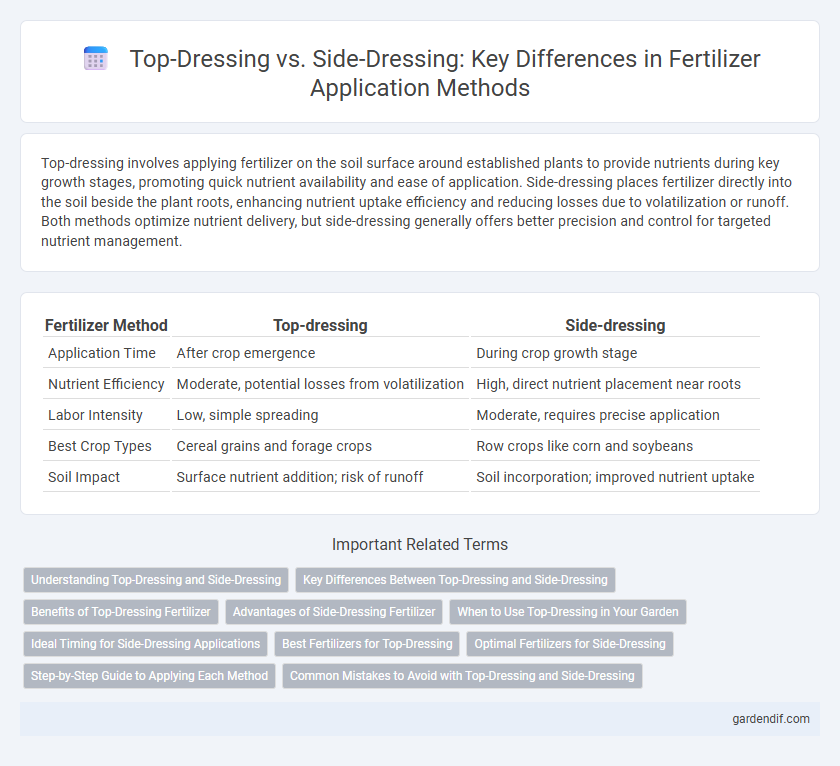
Top-dressing vs Side-dressing Illustration
Top-dressing involves applying fertilizer on the soil surface around established plants to provide nutrients during key growth stages, promoting quick nutrient availability and ease of application. Side-dressing places fertilizer directly into the soil beside the plant roots, enhancing nutrient uptake efficiency and reducing losses due to volatilization or runoff. Both methods optimize nutrient delivery, but side-dressing generally offers better precision and control for targeted nutrient management.
Table of Comparison
| Fertilizer Method | Top-dressing | Side-dressing |
|---|---|---|
| Application Time | After crop emergence | During crop growth stage |
| Nutrient Efficiency | Moderate, potential losses from volatilization | High, direct nutrient placement near roots |
| Labor Intensity | Low, simple spreading | Moderate, requires precise application |
| Best Crop Types | Cereal grains and forage crops | Row crops like corn and soybeans |
| Soil Impact | Surface nutrient addition; risk of runoff | Soil incorporation; improved nutrient uptake |
Understanding Top-Dressing and Side-Dressing
Top-dressing involves applying fertilizer uniformly over the surface of established crops or soil to provide nutrients during the growing season. Side-dressing refers to placing fertilizer in bands beside growing plants, targeting root zones for efficient nutrient uptake. Understanding the timing, method, and crop requirements of both top-dressing and side-dressing enhances nutrient availability and supports optimal plant growth.
Key Differences Between Top-Dressing and Side-Dressing
Top-dressing involves applying fertilizer directly on the soil surface or crop canopy, enhancing nutrient availability during later growth stages. Side-dressing refers to placing fertilizer in bands alongside growing plants, targeting root zones for efficient uptake. Key differences include timing, application method, and nutrient placement, affecting crop nutrient absorption and growth efficiency.
Benefits of Top-Dressing Fertilizer
Top-dressing fertilizer enhances nutrient availability by applying nutrients directly to the soil surface, promoting rapid uptake during critical growth stages. This method improves nitrogen efficiency, reduces nutrient loss, and supports uniform crop development, leading to higher yields. It also minimizes root disturbance compared to side-dressing, preserving soil structure and microbial activity essential for plant health.
Advantages of Side-Dressing Fertilizer
Side-dressing fertilizer offers precise nutrient application directly to the root zone during critical growth stages, enhancing nutrient uptake efficiency and reducing waste. This method improves crop yield and quality by supplying nutrients when plants need them most, particularly nitrogen for leafy growth. Side-dressing also minimizes nutrient leaching and environmental impact by targeting specific plant needs rather than blanket soil application.
When to Use Top-Dressing in Your Garden
Top-dressing is ideal during the early growth stages of plants when nutrients need to be readily available on the soil surface for gradual absorption. Use top-dressing for established lawns, vegetable gardens, and fruit crops to supply consistent nitrogen and improve soil fertility without disturbing root systems. Applying top-dressing in spring or early summer maximizes nutrient uptake and supports healthy, vigorous plant development.
Ideal Timing for Side-Dressing Applications
Side-dressing fertilizer is ideally applied during the crop's active growth stage, typically when plants have developed 3 to 5 leaves, ensuring maximum nutrient uptake and efficiency. This timing aligns nutrient availability with peak demand periods, enhancing root development and overall yield potential. Proper side-dressing application also minimizes nutrient loss compared to early fertilization methods like top-dressing.
Best Fertilizers for Top-Dressing
Best fertilizers for top-dressing include urea, ammonium nitrate, and controlled-release nitrogen formulations that provide quick nutrient availability and reduce leaching. These fertilizers enhance soil fertility by supplying essential nitrogen during critical crop growth stages, promoting vigorous plant development and higher yields. Choosing fertilizers with balanced nutrient ratios and low salt index ensures efficient nutrient uptake and minimizes potential phytotoxicity.
Optimal Fertilizers for Side-Dressing
Optimal fertilizers for side-dressing prioritize quick nutrient availability and balanced nitrogen, phosphorus, and potassium ratios to support rapid crop growth during critical development stages. Examples include urea, ammonium nitrate, and liquid nitrogen solutions, which are effective when applied near the plant root zone after initial growth. Side-dressing enhances nutrient uptake efficiency and minimizes losses compared to broad applications, making it essential for precise crop nutrient management.
Step-by-Step Guide to Applying Each Method
Top-dressing involves spreading fertilizer evenly over the soil surface or around plants after they have begun growing, usually in small, measured amounts to avoid nutrient burn. Side-dressing requires placing fertilizer in bands alongside the rows of crops, typically 2-4 inches away from plant bases and 1-2 inches deep to enhance root absorption. Both methods ensure efficient nutrient delivery, with top-dressing suitable for quick nutrient boosts and side-dressing promoting targeted root uptake during critical growth stages.
Common Mistakes to Avoid with Top-Dressing and Side-Dressing
Common mistakes to avoid with top-dressing and side-dressing include applying fertilizers at incorrect growth stages, leading to nutrient imbalances or burn. Over-application near plant stems can cause root damage and reduced uptake efficiency, while uneven distribution results in patchy crop growth. Timing applications to match nutrient demand and calibrating equipment precisely ensures optimal fertilizer use and maximizes crop yield.
Top-dressing vs Side-dressing Infographic

 gardendif.com
gardendif.com